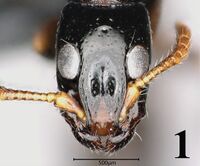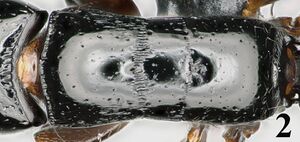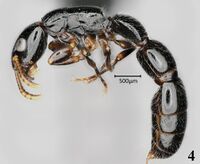Simopone fisheri
| Simopone fisheri | |
|---|---|

| |
| Scientific classification | |
| Kingdom: | Animalia |
| Phylum: | Arthropoda |
| Class: | Insecta |
| Order: | Hymenoptera |
| Family: | Formicidae |
| Subfamily: | Dorylinae |
| Genus: | Simopone |
| Species group: | grandidieri |
| Species: | S. fisheri |
| Binomial name | |
| Simopone fisheri Chen, Chen & Zhou, 2019 | |
This species, known only from type material, was hand collected from a twig nest in an evergreen broad-leaved forest.
Identification
Chen et al. (2019) - A member of the grandidieri species group. Morphologically most similar to Simopone oculata, but is easily differentiated from it by dorsolateral borders of pronotum round and not forming longitudinal carina. The new species is also similar to Simopone yunnanensis but is easily differentiated from it by dorsolateral portion of pronotum longitudinally striate and metanotal groove present. The dorsolateral borders of pronotum in S. yunnanensis forms a right angle but never forms longitudinal carina; the original description of S. yunnanensis by Chen et al. (2015) needs to be corrected as above.
Keys including this Species
Distribution
Latitudinal Distribution Pattern
Latitudinal Range: 22.297° to 22.297°.
| North Temperate |
North Subtropical |
Tropical | South Subtropical |
South Temperate |
- Source: AntMaps
Distribution based on Regional Taxon Lists
Palaearctic Region: China (type locality).
Distribution based on AntMaps
Distribution based on AntWeb specimens
Check data from AntWeb
Countries Occupied
| Number of countries occupied by this species based on AntWiki Regional Taxon Lists. In general, fewer countries occupied indicates a narrower range, while more countries indicates a more widespread species. |

|
Estimated Abundance
| Relative abundance based on number of AntMaps records per species (this species within the purple bar). Fewer records (to the left) indicates a less abundant/encountered species while more records (to the right) indicates more abundant/encountered species. |

|
Biology
Castes
Worker

| |
| . | |
Nomenclature
The following information is derived from Barry Bolton's Online Catalogue of the Ants of the World.
- fisheri. Simopone fisheri Chen, Chen & Zhou, 2019: 24, figs. 1-4 (w.) CHINA (Guangxi).
- Type-material: holotype worker, 8 paratype workers.
- Type-locality: holotype China: Guangxi, Longzhou County, Bingqiao Town, Daqingshan, 22.297°N, 106.695°E, 500 m., 21.v.2016, No. G160312, evergreen broad-leaved forest, nest in twig (Z. Chen); paratypes with same data.
- Type-depositories: GNUC (holotype); GNUC, SFCY (paratypes).
- Distribution: China.
Head in full-face view nearly rectangular, longer than broad (CI 76–78), broadest around the level of eye; sides broadly weakly convex, but shallowly concave anterior to eyes; posterior margin concave; posterolateral corner forming a blunt angle. Mandibles subtriangular, with masticatory margin finely dentate. Clypeus without median carina; anterior margin of median portion of clypeus broadly rounded. Frontal carinae horizontal, widely separated by broad frontal area; outer margins of frontal lobe divergent posteriad and extending beyond to the anterior margins of eyes. Antennae 11-segmented; scape short, clavate, not reaching to anterior margin of eye. Antennal scrobe extending from antennal socket to the anterior margin of the eye. Eyes large, occupying about 1/3 length of the side of head; the center point of eye posterior to the mid-length of head; outer margin of eye in full-face view not touching the lateral margin of head. Median and lateral ocelli present, minute and closely approximated to each other.
Mesosoma in lateral view weakly convex on pronotum, with a weak concavity between pronotum and mesonotum. Pronotal disc in dorsal view with anterodorsal margin carinate and convex anteriad; humeri narrowly round (not sharply angulate); lateral margins weakly convergent posteriad. Promesonotal suture in dorsal view recognized as a narrow and longitudinally rugose band, slightly convex anteriad. Dorsolateral borders of pronotum and mesonotum not forming longitudinal carina. Metanotal groove in dorsal view as a very narrow band, slightly convex posteriad. Dorsum and posterior slope of propodeum in lateral view forming a round corner, without a carina between the two faces.
Petiole (AII) longer than broad (AIIW/AIIL = 0.85), with anterodorsal carina strong and straight, in dorsal view with sides divergent posteriorly, with posterolateral corner narrowly round; dorsum in lateral view continuously convex; posteroventral corner of subpetiolar process produced as an acute hook or spine. Postpetiole (AIII) as broad as long, a little longer than high, in lateral view with sides almost parallel; dorsum in lateral view moderately convex. A conspicuous girdling constriction present between AIV and AV.
Head scattered with minute piligerous punctures, with spaces between punctures smooth and shining; mesosoma largely smooth and shining, with sparse minute piligerous punctures, longitudinally striate on posterolateral portion of dorsal face of pronotum, central portion of lateral face of pronotum and most part of metapleuron smooth and shining; waist segments and gaster largely smooth and shining, with sparse minute piligerous punctures, finely reticulate on anterior portions of AV, AVI and AVII.
Body scattered with short and decumbent background hairs; sides of head with one or two long setae; inner margin of each eye posteriorly with two long setae posteriorly; scape with several suberect setae; antennal funiculi with abundant setae; anterior portion of mesosoma scattered with long suberect setae; petiole, postpetiole, tergite of AIV, posterior edges of AV and AVI, pygidium and hypopygium with abundant setae.
Body color black; antenna, trochanter, spur, apical portion of tarsi yellowish brown
Paratypes. AIIL 0.79–0.83, AIIW 0.66–0.69, AIIIL 0.72–0.77, AIIIW 0.72–0.75, AIVL 0.81–0.86, AIVW 0.85–0.87, CI 76–78, ED 0.29, EP 85–86, HL 1.04–1.06, HW 0.80–0.83, SI 44–46, SL 0.27–0.28, SW 0.12–0.13, TL 6.01–6.12, WL 1.45–1.49, AIIW/AIIL 0.82–0.85, AIIIW/AIIIL 0.97–0.99.
Similar to holotype, with the following exceptions. The metanotal suture of one paratype specimen well developed but incomplete and another one paratype specimen faintly marked.
Type Material
- Holotype, worker, Guangxi, Longzhou County, bingqiao Town, Daqingshan, 500m, China, 22°17′49″N 106°41′42″E / 22.297°N 106.695°E, 21 May 2016, Zhilin Chen, G160312, Guangxi Normal University; evergreen broad-leaved forest, nest in a twig, hand collecting.
- Paratype, 7 workers, Guangxi, Longzhou County, bingqiao Town, Daqingshan, 500m, China, 22°17′49″N 106°41′42″E / 22.297°N 106.695°E, 21 May 2016, Zhilin Chen, G160312, Guangxi Normal University; evergreen broad-leaved forest, nest in a twig, hand collecting.
- Paratype, 1 worker, Guangxi, Longzhou County, bingqiao Town, Daqingshan, 500m, China, 22°17′49″N 106°41′42″E / 22.297°N 106.695°E, 21 May 2016, Zhilin Chen, G160312, Southwest Forestry University, Kunming, China; evergreen broad-leaved forest, nest in a twig, hand collecting.
Etymology
The new species is named in honor of Brian L. Fisher (California Academy of Sciences, United States of America) for his outstanding contributions to ant systematics.
References
- Chen, Z., Chen, Y., Zhou, S. 2019. Simopone fisheri sp. n., a new species of Dorylinae ants (Hymenoptera, Formicidae) from China, with an illustrated key to the S. grandidieri-group species. ZooKeys 838: 21–33 (doi:10.3897/zookeys.838.29465).
References based on Global Ant Biodiversity Informatics
- Chen Z., Y. Chen Y, and S. Zhou. 2019. Simopone fisheri sp. n., a new species of Dorylinae ants (Hymenoptera, Formicidae) from China, with an illustrated key to the S. grandidieri-group species. ZooKeys 838: 21–33.
